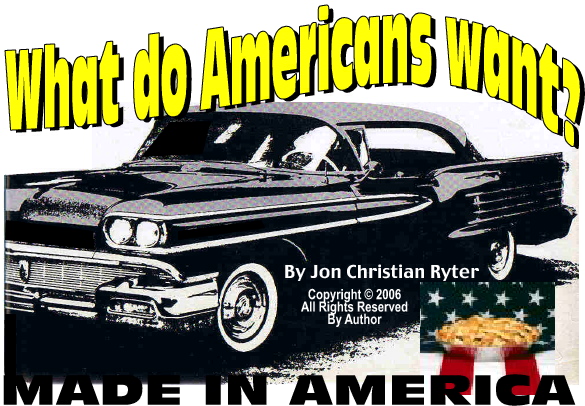
News
Behind the Headlines
Two-Cents Worth
Video of the Week
News Blurbs
Articles
Testimony
Bible Questions
Internet Articles (2015)
Internet Articles (2014)
Internet
Articles (2013)
Internet Articles (2012)
Internet Articles (2011)
Internet Articles (2010)
Internet Articles
(2009)
Internet Articles (2008)
Internet Articles (2007)
Internet Articles (2006)
Internet Articles (2005)
Internet Articles (2004)
Internet Articles (2003)
Internet Articles (2002)
Internet Articles (2001)

 eneral
Motors recently embarked on a national advertising campaign in
which they asked the question: "Do American car companies
know what Americans want?" In answering their own question,
GM said "...our newest vehicles account for 30% of our
total US sales...in head-to-head comparisons," GM said,
"our cars and trucks stand up to anyone's—foreign
or domestic." GM claimed their vehicles perform better
with fewer problems, adding: "That's the focus. And that's
the mission. At the global car company that's proud to be American."
eneral
Motors recently embarked on a national advertising campaign in
which they asked the question: "Do American car companies
know what Americans want?" In answering their own question,
GM said "...our newest vehicles account for 30% of our
total US sales...in head-to-head comparisons," GM said,
"our cars and trucks stand up to anyone's—foreign
or domestic." GM claimed their vehicles perform better
with fewer problems, adding: "That's the focus. And that's
the mission. At the global car company that's proud to be American."
The kicker? Under the asterisks in the ad on the performance-driven American vehicles—in the small print we never read—the ad said: "General Motors Corporation—Oshawa #2, Ontario, received the lowest number of problems per 100 vehicles for plants in North/South America..." The American consumers GM was talking about—the people expected to buy the cars and trucks GM makes—are US consumers. But the Americans who manufactured those shiny new vehicles are Americans only in the sense that they live in North, Central or South America with, increasingly, fewer of them living in the United States.
When it comes to cars, what do Americans want? It's simple. Cars made in America—or more specifically, cars made in the United States of America. Not Mexico. Not South America. Not Central America. Not even our closest neighbor and ally—Canada. But even most specifically, not American-branded cars made in China and snuck back to the United States through NAFTA's tariff-free swinging doors via Mexico.
Twenty-eight nations (all hoping to capitalize on the affluence of the postwar American consumer—including the United Kingdom and the United States (through America's first globalist president, Harry S. Truman) signed the General Agreement on Tariffs and Trade on Oct. 23, 1947. GATT went into affect on Jan. 1, 1948, starting the slow motion domino affect that ultimately led to the current jobs drain that is siphoning 15 million high paying union jobs a year from the United States each year.
GATT stalled during the 5th round of negotiations in 1962 when England walked away from the table. The Brits balked at the notion that second and third world countries should have access to the consumer markets in the industrialized nations—particularly England—but that the third world countries would not be obligated to buy an equivalent amount of consumer goods from them. As a result, GATT remained a powerless paper tiger until Bill Clinton became president of the United States. Most of the WTO agreements are the result what has become known as the Uruguay Round. It was signed at Marrakesh in April 1994. There were about 60 agreements, totaling some 550 pages.
The Uraguay Round actually started during the Reagan years, with President Ronald Reagan unwilling to surrender the manufacturing strength of the United States to accommodate the transnational industrialists who viewed the human capital in the third world as the primary consumer of the 21st century. Many of the world's 185 countries which signed the revised agreement in Marrakesh in April 1994 still haven't ratified it. Most waited to see what happened in the United States after Clinton signed the agreement on December 8, 1994. Since they are now profiting from GATT, most see no need to sign something that would legally bind them to concessions only a fool would make.
The General Agreement on Tariffs and Trade officially bound all signatory nations on January 1, 1995. Within the new trade bureaucracy was the enforcement arm—the World Trade Organization [WTO]. The WTO is the engine of the emerging world government. A Dispute Settlement Body within the WTO was empowered to investigate unfair trade complaints and arbitrarily deal with them. The WTO has the power to authorize an "aggrieved country" to take reprisals against the erring nation. As has been the case, most of the WTO reprisals have been taken against the United States which is perceived as the economic bully of the world.
While it is common knowledge that Canada subsidizes most of its industries that export to the United States and that China uses prison laborers without pay to manufacture many of the products it sells abroad, in Aug., 2001, the WTO issued sanctions against the United States for giving US exporters tax breaks in order to make them more competitive overseas. The fine assessed to the United States was $4 billion. In April, 2004, the WTO ruled that US subsidies to cotton farmers were unfair and gave American cotton farmers an unfair advantage in the United States. In August, the Bush Administration was sanctioned again for providing subsidies to American farmers trying to compete in the emerging economies that were charging illegal tariffs on consumer goods made in the United States. In March, 2005 Brazil complained that the Bush was still unfairly subsidizing US cotton farmers.
Why is any of this important? As consumers, we all like a deal. So anything that drives down retail prices is good for the American consumer. Right? GATT regulations, created by globalist transnational industrialists, bankers and merchant prices to recast the economic infrastructure of the world, is interpreted and enforced by the "economic police" in the WTO to suit the agenda of the transnationalists who are behind world government. These global regulations are stacked against the United States.
We need to keep those thoughts foremost in our minds as we plan major purchases—like a new car. With the job market getting tough in the United States, and average household incomes dropping, we need to save money on the major purchases we are required to buy.
And, let's face it, cars made in second and third world countries are cheaper than cars made in Detroit—or any of the other soon-to-be deserted cities in America's decaying, boarded-up industrial belt And, that's the problem. In World War II, the United States fueled, fed and supplied all of its allies with the munitions and machines of war and simultaneously fought enemies on two continents. What made America the most powerful nation in the history of the world was her industrial strength. America's peacetime factories created almost half the world's jobs and 40% of the consumable goods sold throughout the nations of the world. America was self-sufficient. Everything we needed to survive and prosper in a hostile world was made here. And, to the rest of the world, that was a problem.
To the rest of the world, America was the land of the free and the home of the greedy. Our allies and, more important, our "former" enemies, demanded access to the American consumers so they could rebuild their war-damaged economies—and their armies. American politicians, fed by the greedy transnationalists attempting to create Utopia, agreed. America's politicians (on both sides of the aisle). who were financed by transnational industrialists, were aware that tomorrow's consumers did not live in the United States. Most of them know that at the end of the transcontinental CAFTA commerce corridor will be a new, orderly global society. The barons of banking and the courtesans of commerce who are diligently constructing the world economy know that tomorrow's consumers—the human capital of the princes of industry—live in the overpopulated, emerging third world nations. All those prospective consumers need to fulfill the utopian dreams of the transnational industrialists and barons of business, were jobs—our jobs. Union jobs.
Fueling the transnationalists efforts to industrialize the third world were the labor unions in the United States—greedy for new members in the emerging economies of the third world —and the socialist Democratic congressional leadership in Washington, DC that drew much of their support from Labor and the votes Big Labor controlled. But these would be union jobs without the bargaining clout of Taft-Hartley or any other law guaranteeing collective bargaining rights. The transnational industrialists intended to pull the teeth and break the backs of Labor by moving their factories to nations without labor laws that would force them to negotiate with labor through their unions.
The handwriting was already on the wall—Me'ne, Me'ne, Te'kel, Uphar'sin—in the late 1960s and early 1970s when the American clothing industry was virtually destroyed by cheap textiles from Asia. Because the nations of Europe and Asia envied the prosperity of America, the globalists—with one eye on the human capital of Asia that would soon become their chattel—sold out America and signed the General Agreement on Trade and Tariffs that led to the World Trade Organization. But until Bill and Hillary Clinton forced the North American Free Trade Agreement through the Democratically-controlled Congress in 1993, the globalists were checkmated.
The courtesans of commerce could not steal the United States' job base without a severe penalty. They would have no mass market in which to sell the goods made by the former US jobs. Goods coming back into the United States would be slapped with tariff's high enough to make those good noncompetitive with the products still being made in the USA in order to protect the American job base. But the titans of industry who put up the millions needed to elect the co-presidency of Bill and Hillary in 1992 got their money's worth.
A tariff-free swinging door was created and the products created by the jobs America exported returned to the United States as American-branded goods. Union jobs fled the United States and sweat shop goods returned. Greedily, American consumers grabbed the bargains without realizing that the only thing the United States was exporting were jobs—and their were next.
Nations—and the consumers within those nations have a choice. They can have an upscale standard of living, or they can have cheap goods. They can't have both although the greedier we are the more reasonable that myth becomes. Because of our penchant for the proverbial bargain, we have watched the taskmasters of the New World Order deliberately break the industrial back of America and watch as, one by one, America's premier industries, have closed their doors in America and transferred the core of their manufacturing to Canada, China, India, Indonesia, Mexico, Pakistan, and the emerging economies of Central and South America.
Over the last few months we have sadly witnessed the first tragic spasms of the death throes of the automobile industry in the United States. Where are the mourners? To the 47,600 hourly auto workers who were forced to accept severance packages from GM and its subsidiary Delphi, they wandered where was the United Auto Workers? Over the past year, GM closed a dozen plants in North America, terminated hundreds of white collar workers, reduced salaries on those lucky enough to still have a job, and shifted much of the health care costs from the company to the hourly retirees who were not in a position to protest. To 113 thousand GM workers, it was a heart-wrenching decision—take early retirement or wait for the axe to fall. Most of them initially looked to the UAW to save their jobs, but there were no jobs left to save—and the UAW, which is now part of a UN-NGO under the AFL-CIO—and the labor unions lacked the power to bring management to the bargaining table since all of the furniture had already been moved to the new factories in the America south of the border.
The buyout packages for US GM workers ranged from a low of $70,000 to a high of $140,000. Industry analysts told the media that the $3.8 billion buyout package is probably the largest buyout in corporate history. Employees taking the buyout take it in lieu of post-retirement benefits, including health care. However, those employees who have vested pension benefits would receive them. Anyone taking early retirement will receive a lump sum settlement of $35,000 and their normal pension and health care benefits at age 65 or 30 years of service to GM. While 46,900 GM employees agreed to the settlement, only 4,600 took the cash buyout. The balance took early retirement.
General Motors lost $10.6 billion last year. The buyout is expected to help GM recoup $8 billion this year. Ford Motor Company is experiencing the same problem and will offer their hourly employees the same deal later this year. Eighty-seven thousand Ford employees will be eligible. Where Ford estimates that 11,000 employees will take the company's buyout offer, based on GM, it is likely that 30,000 Ford employees will take the buyout. There is an ominous reality taking place that is foreboding omen of the future of the labor union in America. Union employees cost GM about $81 an hour in fiscal year 2005 when you combine income and benefits—or about $168 thousand per employee without considering overtime. As GM and Ford jettisons the expensive union workers, they will replace many of them with part-time temps who will be paid $18 to $20 an hour without benefits, and bringing the US facilities in line with competition around the world. In 1970 the UAW had 1,5 million members. A year ago, UAW membership was around 600 thousand. Within another year, it will be around half that, sapping the union of its strength. Big Three contracts are up for renewal next year. The UAW is already preparing for battle, but its been forced to move $60 million from its strike fund into its general operating fund to offset the loss of dues this buyout will cause. How much clout does the UAW still have? The average Big Three hourly employee is 50 years old. If the union attempts to leverage Ford, Chrysler or GM, the Big Three will offer another round of buyouts and kill the union.
As much of a financial blow the buyout has been to the UAW, the real economic impact will be felt by the cities that were home to GM. They are going to experience a devastating revenue drain as 46,900 GM paychecks won't be cashed and spent each week. And, by years' end, another 30 thousand Ford paychecks won't be buying groceries at the local supermarket in Dearborn; or buying new clothes, or making mortgage payments or installment payments on a new refrigerator or plasma TV.
But even more, when all of the jobs are exported, what will be gone from the United States will be the industrial readiness that allows a nation to change from peacetime to wartime production overnight. Our capacity to convert raw materials into steel, and steel into ships, tanks, airplanes and guns will be gone because our steel industry is gone. Our airplane factories are almost gone—and what planes Boeing and Lockheed are making today have been sold to the People's Republic of China.
GM asked the question: what do Americans want? Let me answer them. More than anything else, Americans want to be secure in their homes—and their nation. They want their borders sealed. They want enough US Border Patrol agents on the wall to keep the illegals on the other side of the border. They want the border sealed tight enough that no more jobs can be exported. And more than anything, Americans want those American branded products that are manufactured in China and routed through Mexico to Brownsville, Texas to be hit with a tariff wall so extreme that the slave labor Chinese goods will cost so much that they will rot on the shelves at Wal-Mart.
What do Americans want? They want politicians to stop lying to them. They want politicians to protect their country from the transnational profiteers who are creating a global new world order controlled by greedy men who want to send our jobs to the emerging nations where tomorrow's consumers have nothing and need everything—except a paycheck. What do Americans want? More than anything else, they want to keep their jobs—and paychecks—in America because it was the investment of their sweat equity that built the corporations that are now exporting their jobs to the third world.

Copyright © 2009 Jon Christian Ryter.
All rights reserved.



